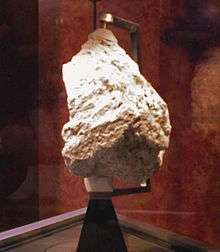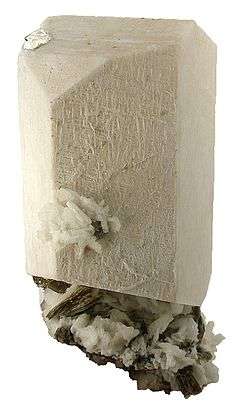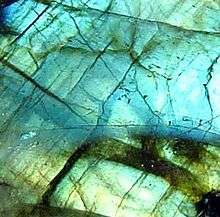Feldspar

Feldspars (KAlSi3O8 – NaAlSi3O8 – CaAl2Si2O8) are a group of rock-forming tectosilicate minerals that make up as much as 60% of the Earth's crust.[2]
Feldspars crystallize from magma as veins in both intrusive and extrusive igneous rocks and are also present in many types of metamorphic rock.[3] Rock formed almost entirely of calcic plagioclase feldspar (see below) is known as anorthosite.[4] Feldspars are also found in many types of sedimentary rocks.[5]
Etymology
The name feldspar derives from the German Feldspat, a compound of the words Feld, "field", and Spat, "a rock that does not contain ore". The change from Spat to -spar was influenced by the English word "spar", a synonym for "mineral".[6] Feldspathic refers to materials that contain feldspar. The alternate spelling, felspar, has largely fallen out of use.
Compositions
This group of minerals consists of tectosilicates. Compositions of major elements in common feldspars can be expressed in terms of three endmembers:
Potassium-Feldspar (K-spar) endmember KAlSi3O8[2]
Anorthite endmember CaAl2Si2O8[2]
Solid solutions between K-feldspar and albite are called alkali feldspar.[2] Solid solutions between albite and anorthite are called plagioclase,[2] or more properly plagioclase feldspar. Only limited solid solution occurs between K-feldspar and anorthite, and in the two other solid solutions, immiscibility occurs at temperatures common in the crust of the earth. Albite is considered both a plagioclase and alkali feldspar.
Alkali feldspars
The alkali feldspars are as follows:
- orthoclase (monoclinic)[7]—KAlSi3O8
- sanidine (monoclinic)[8]—(K,Na)AlSi3O8
- microcline (triclinic)[9]—KAlSi3O8
- anorthoclase (triclinic)—(Na,K)AlSi3O8
Sanidine is stable at the highest temperatures, and microcline at the lowest.[7][8] Perthite is a typical texture in alkali feldspar, due to exsolution of contrasting alkali feldspar compositions during cooling of an intermediate composition. The perthitic textures in the alkali feldspars of many granites can be seen with the naked eye.[10] Microperthitic textures in crystals are visible using a light microscope, whereas cryptoperthitic textures can be seen only with an electron microscope.
Barium feldspars
Barium feldspars are also considered alkali feldspars. Barium feldspars form as the result of the substitution of barium for potassium in the mineral structure. The barium feldspars are monoclinic and include the following:
- celsian—BaAl2Si2O8[11]
- hyalophane—(K,Ba)(Al,Si)4O8[12]
Plagioclase feldspars
The plagioclase feldspars are triclinic. The plagioclase series follows (with percent anorthite in parentheses):
- albite (0 to 10)—NaAlSi3O8
- oligoclase (10 to 30)—(Na,Ca)(Al,Si)AlSi2O8
- andesine (30 to 50)—NaAlSi3O8—CaAl2Si2O8
- labradorite (50 to 70)—(Ca,Na)Al(Al,Si)Si2O8
- bytownite (70 to 90)—(NaSi,CaAl)AlSi2O8
- anorthite (90 to 100)—CaAl2Si2O8
Intermediate compositions of plagioclase feldspar also may exsolve to two feldspars of contrasting composition during cooling, but diffusion is much slower than in alkali feldspar, and the resulting two-feldspar intergrowths typically are too fine-grained to be visible with optical microscopes. The immiscibility gaps in the plagioclase solid solutions are complex compared to the gap in the alkali feldspars. The play of colours visible in some feldspar of labradorite composition is due to very fine-grained exsolution lamellae.
Weathering
Chemical weathering of feldspars results in the formation of clay minerals.[13]
Production and uses
About 20 million tonnes of feldspar were produced in 2010, mostly by three countries: Italy (4.7 Mt), Turkey (4.5 Mt), and China (2 Mt).[14]
Feldspar is a common raw material used in glassmaking, ceramics, and to some extent as a filler and extender in paint, plastics, and rubber. In glassmaking, alumina from feldspar improves product hardness, durability, and resistance to chemical corrosion. In ceramics, the alkalis in feldspar (calcium oxide, potassium oxide, and sodium oxide) act as a flux, lowering the melting temperature of a mixture. Fluxes melt at an early stage in the firing process, forming a glassy matrix that bonds the other components of the system together. In the US, about 66% of feldspar is consumed in glassmaking, including glass containers and glass fiber. Ceramics (including electrical insulators, sanitaryware, pottery, tableware, and tile) and other uses, such as fillers, accounted for the remainder.[15]
In earth sciences and archaeology, feldspars are used for K-Ar dating, argon-argon dating, and luminescence dating.
In October 2012, the Mars Curiosity rover analyzed a rock that turned out to have a high feldspar content.[16]
-
Feldspar output in 2005.
-

Lunar ferrous anorthosite #60025 (plagioclase feldspar). Collected by Apollo 16 from the Lunar Highlands near Descartes Crater. This sample is currently on display at the National Museum of Natural History in Washington, D.C.
-

First X-ray view of Martian soil—feldspar, pyroxenes, olivine revealed (Curiosity rover at "Rocknest", October 17, 2012).[1]
- ^ Brown, Dwayne (October 30, 2012). "NASA Rover's First Soil Studies Help Fingerprint Martian Minerals". NASA. Retrieved October 31, 2012.
See also
References
-
 This article incorporates public domain material from the United States Geological Survey document: "Feldspar and nepheline syenite" (PDF).
This article incorporates public domain material from the United States Geological Survey document: "Feldspar and nepheline syenite" (PDF).
- ↑ "Feldspar". Gemology Online. Retrieved 8 November 2012.
- 1 2 3 4 5 6 Feldspar. What is Feldspar? Industrial Minerals Association. Retrieved on July 18, 2007.
- ↑ "Metamorphic Rocks." Metamorphic Rocks Information. Retrieved on July 18, 2007
- ↑ Blatt, Harvey and Tracy, Robert J. (1996) Petrology, Freeman, 2nd ed., pp. 206–210 ISBN 0-7167-2438-3
- ↑ "Weathering and Sedimentary Rocks." Geology. Retrieved on July 18, 2007.
- ↑ Harper, Douglas. "feldspar". Online Etymology Dictionary. Retrieved 2008-02-08.
- 1 2 "The Mineral Orthoclase". Feldspar Amethyst Galleries, Inc. Retrieved on February 8, 2008.
- 1 2 "Sanidine Feldspar". Feldspar Amethyst Galleries, Inc. Retrieved on February 8, 2008.
- ↑ "Microcline Feldspar". Feldspar Amethyst Galleries, Inc. Retrieved on February 8, 2008.
- ↑ Ralph, Jolyon and Chou, Ida. "Perthite". Perthite Profile on mindat.org Retrieved on February 8, 2008.
- ↑ Celsian–orthoclase series on Mindat.org
- ↑ Celsian–hyalophane series on Mindat.org
- ↑ Nelson, Stephen A. (Fall 2008). "Weathering & Clay Minerals". Professor's lecture notes (EENS 211, Mineralogy). Tulane University. Retrieved 2008-11-13.
- ↑ Feldspar, USGS Mineral Commodity Summaries 2011
- ↑ Apodaca, Lori E. Feldspar and nepheline syenite, USGS 2008 Minerals Yearbook
- ↑ Nasa's Curiosity rover finds 'unusual rock'. (12 October 2012) BBC News.
Further reading
- Bonewitz, Ronald Louis (2005). Rock and Gem. New York: DK Publishing. ISBN 978-0-7566-3342-4.
External links
-
 Media related to Feldspar at Wikimedia Commons
Media related to Feldspar at Wikimedia Commons

